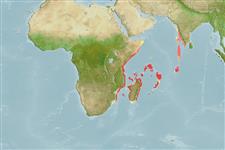Classification / Names
Nomi Comuni | Sinonimi | Catalog of Fishes(Genere, Specie) | ITIS | CoL | WoRMS | Cloffa
>
Acanthuriformes (Surgeonfishes) >
Antigoniidae (Deepbody boarfishes)
Etymology: Antigonia: Daughter of Oedipus and Jocasta, who defied her uncle, king Creon, by performing funeral rites over her brother Polynices and was condemned to be immured in a cave (Ref. 45335); undulata: Name from Latin 'undulata', meaning wavy, reflecting the upper anterior profile of this species..
Environment: milieu / climate zone / depth range / distribution range
Ecologia
marino demersale; distribuzione batimetrica 185 - 438 m (Ref. 57877). Deep-water
Distribuzione
Stati | Aree FAO | Ecosystems | Presenze | Point map | Introduzioni | Faunafri
Western Indian Ocean: Nazareth Bank, off Farquhar, NW Madagascar, Kenya and Mozambique.
Size / Peso / Age
Maturity: Lm ? range ? - ? cm
Max length : 9.8 cm SL maschio/sesso non determinato; (Ref. 57877)
Short description
Chiavi di identificazione | Morfologia | Morfometria
Spine dorsali (totale) : 9; Raggi dorsali molli (totale) : 26 - 29; Spine anali: 3; Raggi anali molli: 24 - 26.
Life cycle and mating behavior
Maturities | Riproduzione | Spawnings | Egg(s) | Fecundities | Larve
Parin, N.V. and O.D. Borodulina, 2005. Antigonia (Caproidae) from the western Indian Ocean: 1. Species with nine spiny rays in the dorsal fin. J. Ichthyol. 45(6):417-428. (Ref. 57877)
IUCN Red List Status (Ref. 130435)
Threat to humans
Harmless
Human uses
Strumenti
Special reports
Download XML
Fonti Internet
Estimates based on models
Preferred temperature (Ref.
123201): 11.8 - 17.9, mean 14 °C (based on 30 cells).
Phylogenetic diversity index (Ref.
82804): PD
50 = 0.5000 [Uniqueness, from 0.5 = low to 2.0 = high].
Bayesian length-weight: a=0.02344 (0.01128 - 0.04870), b=2.97 (2.78 - 3.16), in cm total length, based on LWR estimates for this (Sub)family-body shape (Ref.
93245).
Trophic level (Ref.
69278): 2.9 ±0.3 se; based on size and trophs of closest relatives
Fishing Vulnerability (Ref.
59153): Low vulnerability (10 of 100).
